It’s your first camping trip with your dog – just you, your gear, the great outdoors, and your favorite furry amigo.
You probably (and hopefully) remembered the main camping gear and essentials, like food and clean water for your dog. But now your pup is covered in mud, getting lost in the dark (are those glowing, green eyes his or someone else’s?), and covered in itchy bugs. Within the first hour, this camping trip has gone from a bonding experience in nature to a anxiety-riddled nightmare-scape.
Sounds over-dramatic?
Maybe it is. But proper planning and the right gear for your dog really does make all the difference, and it truly doesn’t take much to keep your new camping companion comfortable, happy and safe.
In this post, we’ll go over the following:
- FAQs
- Tips for Camping With Your Dog
- Essential Gear + Things to Pack
- Optional Gear + Comfy Add-Ons
Let’s get to it!

AFFILIATE LINK DISCLOSURE: This post contains affiliate links. Anything you purchase using one of my links earns me a small monetary kickback at NO extra cost to you. Of course I only link to products that I believe to be useful and good quality. If you want more information on affiliate links, click here.
FAQs ABOUT CAMPING WITH YOUR DOG
CAN DOGS GO CAMPING?
Short answer: Yes! Most dogs looove being outdoors [it’s almost like they revert back to their ancestral roots, temporarily] but you do need to do your research before heading out to make sure your camping plans are above board. Typically I do my camping in free, dispersed campsites [in National Forests] or on BLM land and these campsites are always dog friendly. However, if you’re planning on camping at a developed campground or RV park you may need to double-check on their pet policy. National Parks, for example, only allow dogs in certain campgrounds and have heavy restrictions on where you can walk your dog.
NOTE: Keep in mind, even if dogs are ok’d at your campground there may be a leash rule! The Knot-a-Hitch is a great hands-free [and tangle-free!] dog tether. I talk more about this awesome leash later in the “gear + essentials” section of this post 🙂
HOW DO I TAKE MY DOG CAMPING FOR THE FIRST TIME?
If this is your first camping trip with your dog, think of it as a “test run” and expect things to go wrong. Choose a campsite that’s close to your home so you can quickly pack up and leave if things don’t go according to plan. Most dogs will enjoy the time spent outdoors, but you just never know how your pup will react to a new environment! However, there are plenty of things you can do to ensure that your first camping trip is a success:
- Bring your dog’s favorite items from home [blankets, toys, etc.]. The familiar scent will help them adjust.
- Keep your dog with you at all times. Whether you’re hiking, sleeping, having breakfast or chillin’ by the fire – your dog should always be by your side! You are a calming and familiar presence, and staying close by will help your dog feel safe and comfortable in a new environment.
- Use your rain fly at night. If you want your dog to sleep soundly in your tent, keeping little critters out of a site is a must! Dogs feel like they have to “stand guard” and make sure nothing comes near you while you’re sleeping, so if they see the slightest movement at night you can expect a ton of growling and/or barking.
WHERE DO DOGS SLEEP WHEN CAMPING?
Your dog should sleep in the tent with you while you’re camping. Leaving your dog outside, in a separate section of your tent [if you have a larger tent] or in the car are not good options. Your dog is already in a strange, new situation and adding the stress of being away from you could be scarring for him/her and could also lead to destructive and unsafe behavior.
CAN I LEAVE MY DOG IN A TENT?
Your dog should never be left unattended in your tent. Imagine being trapped in an enclosed, unfamiliar space with no idea why you’re there or when/if your family will be returning. It’s a scary thought! Your dog can’t rationalize why they’re being left alone in a weird, new place. They might try to claw their way out, they might rip into your bedding, they might just be so stressed and traumatized that they never want to see a tent again! It’s best to keep your dog within sight at all times. If you don’t want to, or can’t, let your dog run around outside the tent [and you want to walk about hands-free] consider a dog tether. This one from Ruffwear is amazingly innovative – it’s completely tangle-free and basically works like a doggy zipline!
DOES MY DOG NEED A SLEEPING BAG?
Whether or not your dog needs a sleeping bag is dependent on a variety of different factors:
- What will the weather [at night] where you’re camping? Even temperatures below 50 degrees can become dangerous for some dogs, however, it depends on your dog’s insulation.
- Does your dog usually enjoy sleeping under blankets/pillows at home? If your dog is used to sleeping under the covers, a sleeping bag could be a worthwhile investment! If your dog hates the idea of being “trapped” in blankets, you’ll probably only want to invest in one if the weather calls for it. Even dogs who hate blankets and sleeping bags will crawl underneath if they’re cold enough.
- What is the size/weight of your dog? Smaller + light-weight dogs will get cold more easily.
- How old is your dog? Elderly or sick dogs need to be kept warmer than young, healthy dogs!
- Is your dog a double-coated or single-coated breed? If your dog has an undercoat, they can withstand much colder temperatures than a single-coated breed.

TIPS FOR CAMPING WITH YOUR DOG
1. RESEARCH, RESEARCH, RESEARCH
You want to do thorough research so you know you’re prepared for what’s to come! Some important considerations are:
- Campground Fees. Is there a fee to camp? Make sure you bring cash!
- Campground Restrictions. Are dogs allowed at the campground? Are there leash laws?
- Weather. Dry weather is preferable, especially if you’re camping with your dog!
- Wildlife. Is there dangerous wildlife nearby? Dogs can attract predators [like bears and wolves] and are also known to get curious with venomous snakes!
- Hunting Seasons. If you’re camping on BLM land or in a National Forest [as I often do] you have to be careful during hunting season! Make sure both you and your pup are wearing blaze orange – and it’s probably best to keep your dog on-leash during these times of the year. Hunting wolves and coyotes is legal in many places so you want it to be clear that your dog is A DOG – not a wild animal.
2. MAKE SURE YOUR VACCINES ARE UP-TO-DATE!
For the safety of your pet [and any other pets in the area] having up-to-date vaccines [especially the rabies vaccine] is absolutely essential!
3. PACK THE ESSENTIALS
You’ll need enough food and water for the number of nights you’ll be away, a first aid kit, up-to-date tags, and more! I’ll talk more about the essentials in the next section 🙂
4. START SMALL
If you or your dog are new to camping and/or outdoor life, you should start as small as possible. Easing your dog into things is much more effective than going from 0 to 60. Maybe consider starting with a “day trip” to a campsite rather than an overnight, or camp somewhere close to home so you can bail if you run into any problems.
5. MAKE SURE YOUR DOG IS COMFORTABLE WITH ROAD TRIPS
Getting there is half the fun! Or half the battle, maybe, depending on your dog. If your dog gets severe travel anxiety, you might want to camp close to home – at least until you get him/her acclimated to car rides and camping trips.
6. KNOW YOUR DOG + HIS ON/OFF LEASH CAPABILITIES
You aren’t going to want to hold onto your dog’s leash the entire length of the camping trip – so if your dog isn’t good off-leash [or if you just aren’t sure how he’ll react to being off-leash] consider investing in a dog tether. The last thing you want on your first camping trip is to have a panic attack searching for a lost dog in the woods! Tuna is pretty good off-leash, but I’ll often use the Knot-a-Hitch dog tether when I’m unable to keep a close eye on him. It’s the best dog tether on the market honestly, because it allows your dog to move around, completely tangle-free.
7. DON’T LEAVE YOUR DOG UNATTENDED
You should always have eyes on your dog, whether they are tied up or not. Never leave your dog unattended in a tent or around camp. Your dog could get into things they shouldn’t [toxic plants, stagnant/parasitic water, dead animals, etc.], have an allergy attack [especially if this is a brand new environment], or get too far from camp and either get lost or attract wildlife. Keeping your dog [and yourself] safe is the #1 priority on your camping trip!
8. KEEP YOUR RAIN FLY ON!
If your dog can see through your tent, he’ll be up all night! Trust me. A little mouse or a leaf blowing in the breeze will set your dog off. He feels like it’s his responsibility to “guard” the tent, so it’ll be constant growling and no sleep [for either of you]. Keeping critters and movement out of sight isn’t a fix-all, since your dog can still hear the scuffling, but it helps significantly!
9. PLAN SOME DOG-FRIENDLY ACTIVITIES
Hiking, swimming, playing fetch etc. It’s important to keep your dog busy! It’ll keep them out of trouble and help them fall asleep quicker at night.
10. HAVE AN EMERGENCY PLAN OF ACTION
What will you do if your dog gets bit by a snake? Gets lost? Won’t settle in your tent?
Have a plan of action just in case things don’t go according to plan.
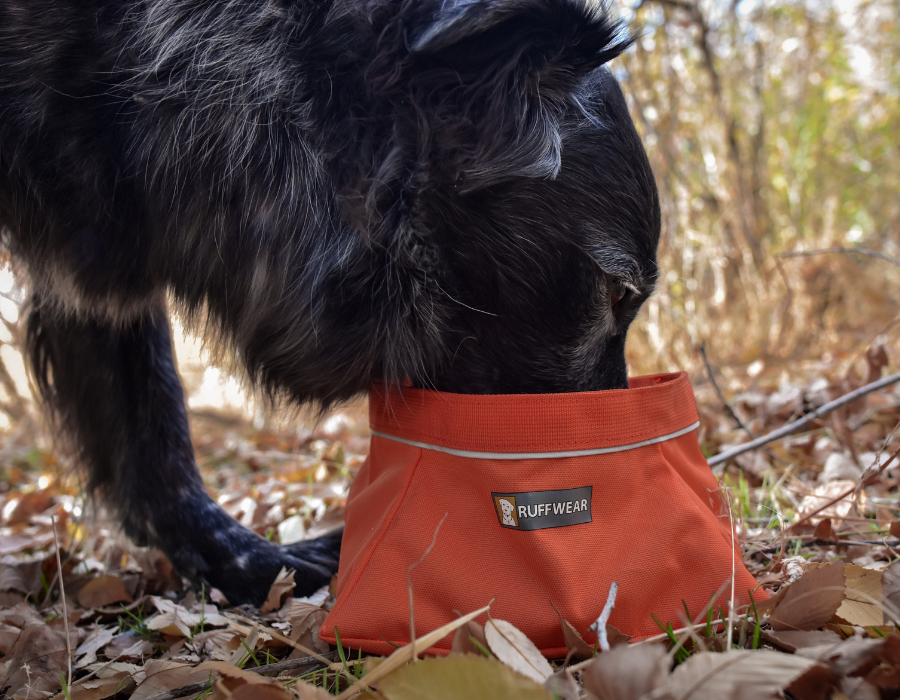
WHAT TO PACK FOR CAMPING WITH YOUR DOG [THE ESSENTIALS]
The must-have’s for every camping dog! These are the top 11 things you should not leave home without.
1. First Aid Kit [for adventure dogs]
There’s a reason this is the #1 essential item for camping with your dog! First Aid Kits are super important for both humans and pups. Whether it’s a sprain, a tick, or a paw injury, there are plenty of instances where First Aid is needed. I use the Trail Dog First Aid Kit from Adventure Medical Kits. It is relatively small, lightweight, and has everything you need for a camping trip with your dog:
- Tweezer / Tick remover
- Gauze, bandages and wraps
- Antiseptic wipes
- Alcohol swabs
- Triple antibiotic ointment
- Saline wound + eye wash
- Syringe
- Antihistamine
- Hydrogen Peroxide [used to induce vomiting if your dog east something poisonous]
NOTE: There is no snake bite kit included – if you’re like me, you’re probably wondering why. Veterinarians advise strongly against purchasing and using snake bite kits. They are not effective and typically cause further damage to your pup. If your dog ever gets bit by a snake, keep the wound below heart-level, keep him/her calm, call the nearest emergency vet to let them know you’re coming in for antivenom, and get there as soon as possible. Antivenom is the only way to effectively treat snake bites! Tourniquets, scalpels and suction devices do not work.
2. Flea + Tick Spray
This is a must, MUST have. Especially if you live in an area where Lyme disease is common. In Idaho we aren’t high risk for tick-borne illnesses, but it’s always better to be safe than sorry.
HOT TIP: Bring a pair of tweezers with you on your trip in case you find a tick or two on your pup [tweezers are included in the Trail Dog First Aid Kit]. You’ll want to gently grip the tick (do not squish it before it’s removed!) and pull slowly but firmly away from the skin, to remove the living tick completely – head and all. Once it’s removed, kill that sucker! Either squish it under a rock or suffocate it by zipping it in a sandwich bag. Don’t ever handle the tick with your bare hands.
3. Water [Plenty of it!] + Dog Food
The rule of thumb for packing in water is this: 1 gallon of water per person/per day. But how much water should you pack for your dog? The rule for dogs is slightly more complicated – it goes by bodyweight. Your dog should drink about 1 oz of water per 1 lb of bodyweight. So if your dog is 65lbs [like Tuna] he should have approximately 65 oz of water per day, which equates to about 1/2 a gallon.
My advice? Pack in double what you think you’ll need. Your dog will be much more active than usual on your camping trip and will likely be drinking water in excess.
As far as food goes, you can pack the usual amount or you can pack a little extra to make up for the extra physical activity. It’s really up to your best judgment. I tend to pack enough for his typical breakfast + dinner servings since Tuna gets a lot of treats on our camping trips!
NOTE: Ruffwear makes an airtight food bag, called the Kibble Kaddie [adorable!], for transporting dog food and keeping it fresh. It even includes an internal storage pouch for your collapsible dog bowls!
4. Collapsible Water/Food Bowls
Any dog bowls will do, but collapsible bowls take up less space and are usually very light-weight, making them an easy addition to your camp gear.
5. Leash
A leash is a must-have, even if you’re planning on letting your dog run around camp untethered. If you see a wild animal nearby or need to temporarily restrain your dog for safety reasons, it’s important to have a leash close by!
Honestly, I will never stop recommending this locking carabiner leash from Ruffwear. I know, I know, everything I own is Ruffwear [or so it seems]. But they really are the end-all-be-all when it comes to outdoor gear for dogs! This leash has been a lifesaver for us. After Tuna broke out of 3 different leashes [even a Kong-brand leash], we decided to invest in something a little more durable. Enter, the Knot-a-Leash! This leash is made from climbing-inspired rope and has a carabiner that locks onto your dog’s collar or harness. It’s impossible to slip out of!
6. Harness
I am definitely partial to harnesses vs. collars. Mostly because they’re safer and more comfortable for your dog, but also because they’re easier to grab and leash-up quickly if your dog is off-leash on a trail or around camp! I really like this one from Ruffwear – it’s padded and comfortable, comes in so many cute colors [campfire orange is my fave!] and has reflective strips so your dog can be seen more easily at night.
7. Up-to-Date Dog Tags
Let’s hope your dog doesn’t get loose on your camping trip, but in the off-chance that he does, you want him to have up-to-date dog tags so he can be returned to you safely. Always leave your dog’s collar or harness on during your camping trip [at least until you’re inside your tent] just in case!
8. Sleeping Bag
I’m listing this under “essentials” simply because for some dogs, it is! Whether you need a sleeping bag for your dog or not depends on a variety of factors [I talked more about “when you need a puppy sleeping bag” in the FAQ section, above!]. Tuna is young, healthy, on the larger side, and a double-coated breed – but he’s gotten cold before when temperatures dropped below freezing.
So if you like to cold-weather camp like I do, this is a worthwhile investment! If temps are warm, your pup might prefer not to be restricted by a sleeping bag. You just need to research the weather, know your dog’s preferences, and consider your dog’s age/weight/health/breed.
9. Brush or Comb
Your dog is going to get crap in his fur. It’s pretty much guaranteed. To keep your tent a little cleaner, give your pup a quick brush before going to bed!
10. Quick-dry Towel
Yet another way to keep your tent as clean as possible! Wipe your pup’s paws before getting into the tent or, better yet, spray them down with this handy portable shower and then dry him off!
11. Poop Bags + a Large Garbage Bag
I know what you’re thinking, “It’s animal poop and we’re in the forest.. who cares?”. But dog poop can actually pollute waterways and introduce foreign bacteria into the environment. Not to mention, it’s unsightly and stinky for future visitors. Picking it up is easy and helps prevent harm from coming to other wildlife, so it’s worth taking the time to pick it up and pack it out.
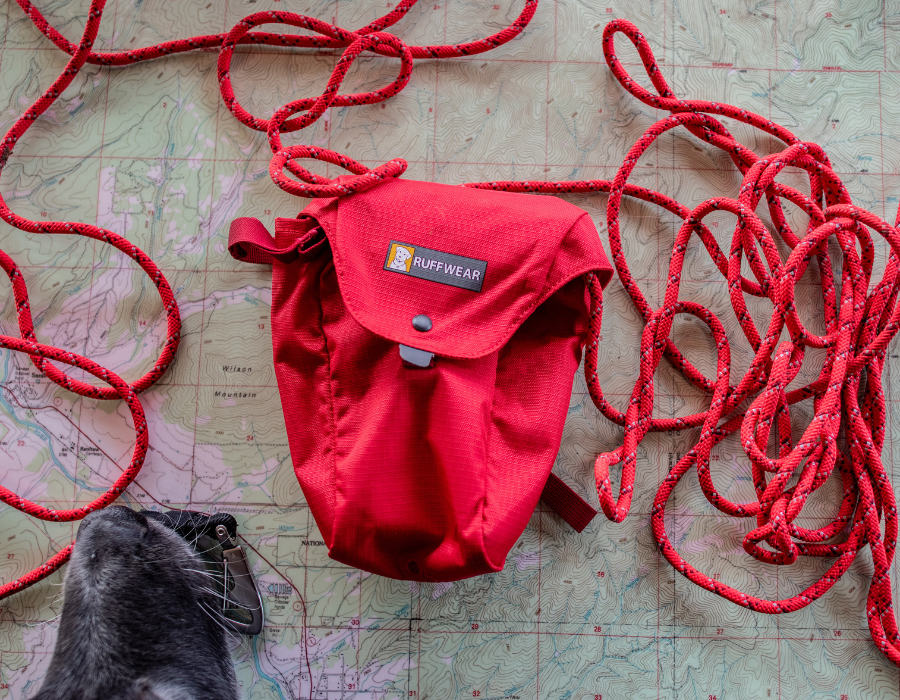
WHAT TO PACK FOR CAMPING WITH YOUR DOG [OPTIONAL GEAR + COMFY ADD-ONS]
These items are totally optional, but definitely will make your camping trip waaay easier and more enjoyable [for both you, and your dog!].
1. A Light-Up Collar or Beacon
There’s a reason this is the first gear item on my list. We often camp on BLM land and let our dog wander around camp (I’m waiting for the hateful comments about off-leash dogs…) but I like to keep Tuna pretty close by so he doesn’t eat something gross or get attacked by coyotes. Trying to catch his little, reflective eyes in the glow of my headlamp just wasn’t working for me – so I ordered this LED collar from REI! It works great, HOWEVER, it could at times get buried in Tuna’s long fur making it difficult to spot him.
Because of that, I ordered the Ruffwear Beacon Safety Light. This small (but SUPER bright) light attaches to a collar or harness. What I love most about it is that you can see the light from an incredibly far distance and it attaches to the top of his harness so it won’t get lost in his thick fur. The Ruffwear Beacon is also rechargeable, waterproof, and has multiple light settings. You can change brightness levels, color (red, blue, or green), and it also has a “blink” setting. The battery life is also a huge selling point! It has an operating time of up to 20 hours.
NOTE: I linked to the blue collar (the one Tuna has) but they also have a rainbow one now! Check it out, here.
2. Light Up Frisbee (And Other Toys, of course)
This light up frisbee is a super-fun interactive toy! But as far as toys you can just leave your dog with, I’d recommend the following [since they are the only toys that have actually withstood my dog’s intense chewing]:
- The Original Kong
- The Kong Squeezz Ball With Squeaker [Tuna loves this one!]
- The Ruffwear Huck-a-Cone [just don’t let them chew the rope!]
- The Ruffwear Gnawt-a-Rock Treat Dispenser Toy
3. Plenty of Training Treats!
Treats are a great way to keep your dog focused on you and attentive to your commands – which is important if you’re planning on letting your dog wander off-leash!
4. Knot-a-Hitch Leash System
This is probably the most innovative dog tethering system I have ever seen! Inspired by rock-climbing techniques, the Knot-a-Hitch leash is meant to be tied to 2 trees while a sliding carabiner (that attaches to your existing leash) allows your dog to move around a large space without getting tangled up. I actually wrote a FULL review post on the Knot-a-Hitch, which you can find here!
The Knot-a-Hitch is super useful if you’re at a campground that requires leashes, or if you just don’t trust your dog to be off-leash around camp.
HOT TIP: This leash is made by Ruffwear – our favorite brand for dog gear: leashes, harnesses, toys and more! I love the use of carabiners and thick, climbing rope in their products. Tuna is a big time puller when he’s on-leash and he has either broken loose or completely snapped all of our previous leashes EXCEPT for our Ruffwear leash. I can’t say enough good things about them!
5. Portable, Pressurized Shower for Your Dog + Camp Needs
The NEMO Helio Pressure Shower is the latest addition to my ever-growing collection of camping gear and, let me tell ya, it’s a game-changer! Not only is it great for rinsing dirty paws, it also makes for a great personal off-grid shower. It works with no batteries and no plug – you just pump it up to pressurize and away you go! It may be made for surfers, but it’s highly rated by car campers and dog owners. Definitely a must-have for adventure pups!
6. Waist-Secured Treat Bag or Fanny Pack
I always keep treats on hand to keep Tuna focused on me and prevent him from wandering. If your dog isn’t so motivated by food, figure out what does motivate them! Squeaky ball, perhaps?
You’ll want something to grab their attention quickly. Or, if your dog doesn’t do well off-leash at all, keep them leashed up on a long lead. Just keep in mind, even if your dog is on-leash you still need to be attentive. You don’t want them getting tangled up.
7. Water Resistant Dog Bed or Blanket
Give your dog a place to lay down and lounge around camp! It’ll keep him cleaner, which will later pay off when you’re sharing a tent.
8. Dirt Bag Seat Cover
If you want to keep your vehicle safe from the dirt and debris that will most definitely attach itself to your dog, cover your seats with this awesome seat cover!
BONUS: This seat cover is also made by Ruffwear, so you know it’s good.
HOT TIP: The seats and floor of our vehicle can both be quickly wiped down with a wet rag – totally resilient materials and perfect for #outdoorlife and wet/dirty dogs. So… Buy a Honda Element and never use seat covers again 😉 I am not sponsored by Honda… just a weird, obsessive fan.
9. Paw Protection [Dog Booties]
Depending on how “wild” your dog gets and what type of terrain you’re camping on, you may want to invest in booties. They aren’t absolutely essential, but they can protect your dogs paws from ticks, sharp rocks, broken glass, hot pavement and more. We love these cute little booties from Ruffwear and they’ve saved Tuna’s paws on numerous occasions! I find them especially handy during wintertime – they protect his paws from road salt and stop ice/snow from getting jammed in between his paw pads.
Going Camping Soon? Check out my personal Camping Gear Checklist!
Dogs aren’t so computer-savvy, so we made it easy to share! Pin this article 🙂
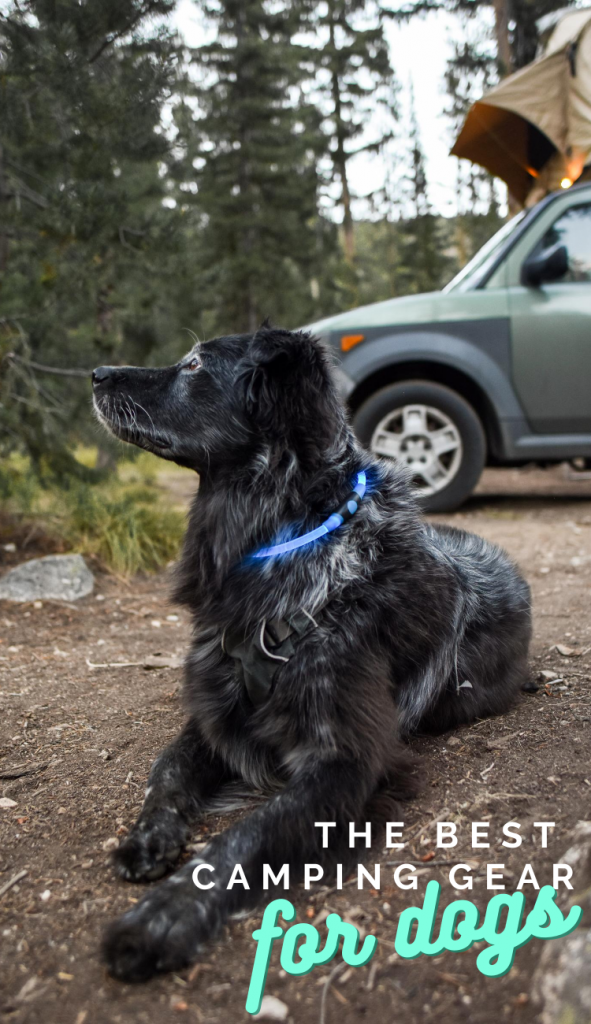

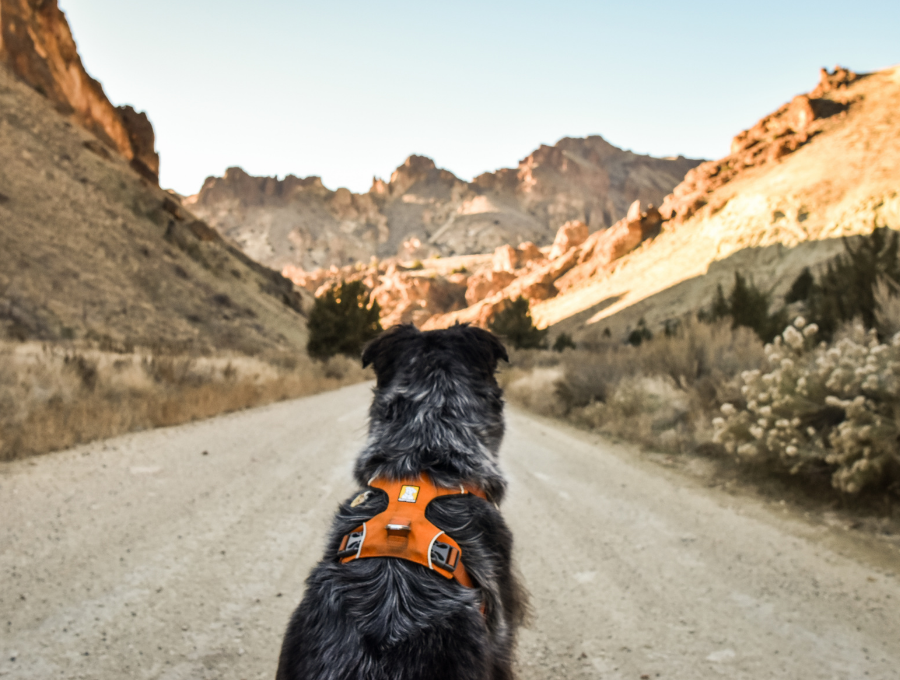
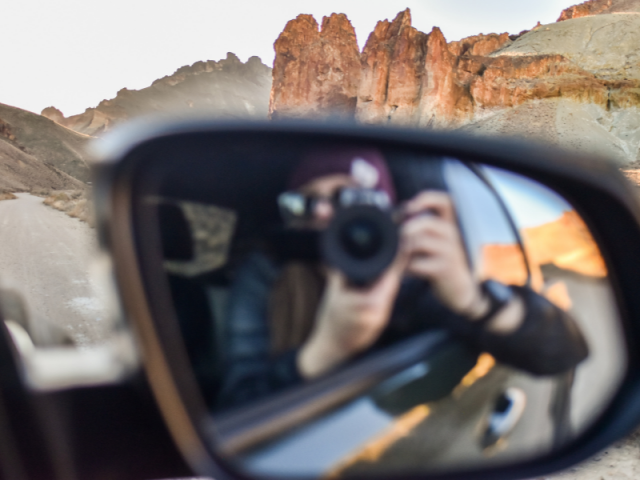
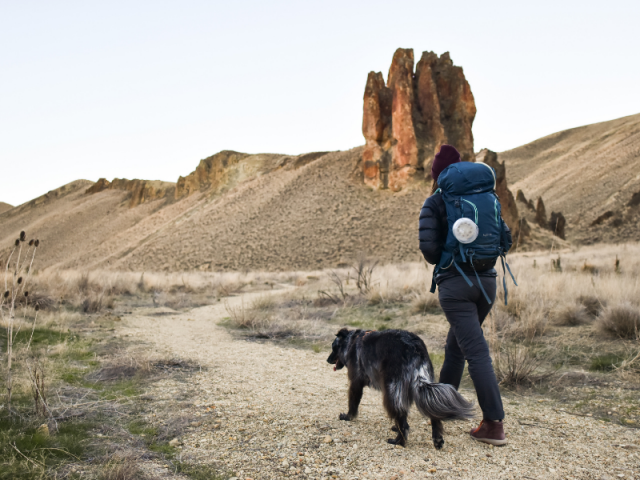
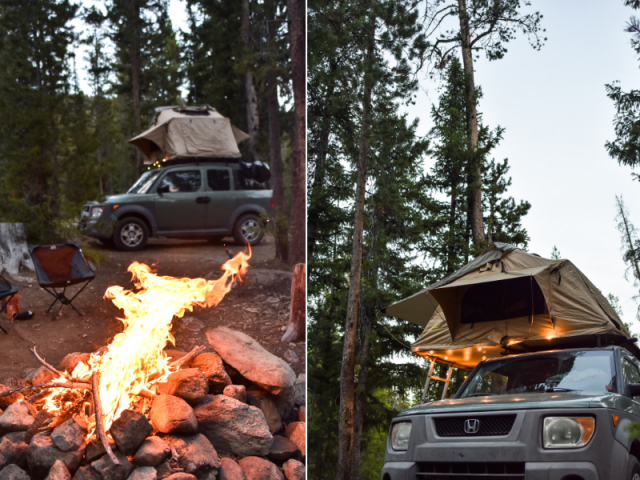
Excellent list of gears! I think dog parents should check the weather conditions before going for the campaign with their dog To determine what Dog Products and accessories to carry for themselves and their dogs for maximum protection.
The author’s passion for both camping and canine companionship shines through, offering practical tips and heartwarming anecdotes that resonate with pet owners. The emphasis on careful planning, from choosing dog-friendly campsites to packing essentials for your furry friend, reflects a thoughtful approach to ensuring a safe and enjoyable experience for both human and canine campers. I particularly appreciate the inclusion of valuable insights on handling potential challenges, such as wildlife encounters or unpredictable weather conditions, showcasing a realistic and responsible perspective on camping with dogs. This article not only provides a helpful guide but also captures the joy and bonding that come with sharing the great outdoors with our four-legged friends.